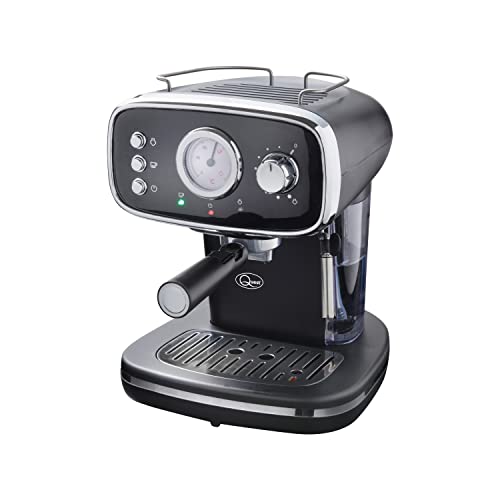How to Use a Coffee and Espresso Maker
A coffee maker produces shots of pressurized water that is forced through very finely packed espresso beans. The result is an intensely tasted drink with a thick crema that is topped with.
Some machines utilize pods or grounds that allow you to choose how strong your brew is, while other machines can also steam milk for cappuccinos as well as lattes. There is even a stovetop version that functions like a moka pot.
1. Buy Guide

The most effective espresso and coffee maker isn't just a device that pours hot water over the grounds. It's also an appliance that can help you create cafe-quality drinks in your home. There are many options available in this area and it can get overwhelming. However there are certain aspects to take into consideration when selecting the right machine.
Understanding the various brewing methods is the first step. Some machines utilize gravity to filter the water through the grounds while others brew with a pump. These differences can affect the final flavor profile and cost.
Although the most advanced coffee-and espresso makers might include digital controls and customizable settings, they're typically the most expensive. It's important to think about the frequency you use your espresso maker and coffee maker, and if the extra cost is worth the cost.
Semiautomatic models are available at a lower price and provide a compromise between manual and automation. These models require some manual work, including grinding and tapping. However they are less expensive than fully automated models and allow for more precise brewing processes.
2. Instructions
It is simple to use the Espresso maker and coffee maker. The most important part is deciding on the right ingredients and preparing the machine. It is best to use freshly ground coffee beans, which are ground using a burr mill designed for espresso. The grinder produces an even, fine powder that releases the finest flavors from the beans. You can make use of a steam wand to make cappuccinos and lattes.
It is necessary to turn the espresso machine on and let it heat up before you prepare any drinks. This can take several minutes, based on the machine's size. It is crucial to ensure that the machine heats evenly. You can speed up the process by using a blank shot, which is running the machine with no grounds in the portafilter. This not only warms your cup but also eliminates the group head to stop the accumulation of dirty water.
After your machine has been preheated, add the coffee grounds into the portafilter. Then, you'll need to tamp the grounds to compact them evenly and tightly. You can buy an tamper on the internet or at the majority of espresso stores. When you're done, turn on the machine and put a small cup underneath each spout. To make espresso, simply switch the control panel to the espresso position. This activates the micro-switches that start the pump and the heating chamber, pushing hot water through the grounds and out of the spouts.
3. Ingredients
A coffee and espresso machine can create numerous drinks. They are among the most versatile brewing tools. This is mainly because they can be used to make espresso and drip-based drinks.
Espresso is an intense coffee drink that is produced by forcing hot high-pressure water through finely ground beans in a short amount of time. Espresso is usually sweeter and thicker than regular coffee. It's also an excellent way to taste flavors that are more complex than the flavors in drip coffee, however it's not for everyone.
The best espresso is dark-roasted and coarsely ground for the best flavor extraction. Vigil suggests that you "bloom your coffee" prior to brewing. This is done by pouring hot water over the coffee and letting it sit for 20-30 seconds (releases flavor notes). After adding the remaining hotwater, you will use the machine's pressure to push the water into the grounds.
Certain machines are more efficient in this regard than others, which is why certain espresso makers are known for being a bit difficult to use. However, with a bit of practice, you'll be making your own espresso at cafe quality in the blink of an eye.
There are some other ways to make almost-espresso without the use of a machine, for instance with siphons (a fancy glass device that uses vapor pressure to immerse the grounds in hot water). But this can be an expensive and time-consuming process.
4. Preparation
Make sure your espresso machine is preheated and connected before you start using it. espressomachines want to maintain the same water temperature throughout the process of brewing so that you can extract the maximum amount of flavor. It's also a good idea to "bloom" or sprinkle some hot water on the coffee grounds for 30 seconds. This will help in releasing the carbon dioxide from the beans and improve the taste of your espresso.
After the brew cycle has been completed, remove the portafilter. You can make espresso using an espresso maker to make single and double shots, or a steam milk frother or wand make popular cafe drinks such as lattes and cappuccinos. Add a bit of sugar to your espresso shot for a sweeter, more delicious drink.
You can make use of your espresso maker brew regular coffee however you'll need make use of a filter since most models aren't able to hold enough to make a full pot. To make a great pot of coffee, you'll must start with freshly ground beans that have already been ground to a proper consistency.
You can also try making use of different kinds of water. Hard water is rich in minerals that can cause mineral buildup and result in a less tasty brew. Soft or filtered water will reduce this buildup.
